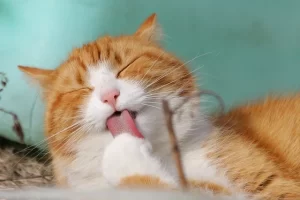Welcome to the comprehensive guide on how to prevent your cat from scratching your precious furniture! If you’re a cat lover, you’ve likely encountered the challenge of dealing with furniture scratches at some point. While scratching is a natural behavior for cats, it can be frustrating and even disheartening when your favorite furniture becomes the target of this behavior.
However, before despairing or considering getting rid of your furry feline, it’s important to understand why cats scratch furniture and how we can redirect this behavior in a positive way. Throughout this guide, we’ll explore not only the reasons behind furniture scratching but also a variety of strategies and alternatives to help your cat express their natural instincts more appropriately.
Cats scratch furniture for a variety of reasons, ranging from sharpening claws to marking territory and stretching muscles. This behavior is intrinsic to the nature of felines and should not be negatively suppressed. By understanding the motivations behind scratching, we can adopt a more compassionate and effective approach to dealing with this unwanted behavior.
One of the primary solutions to prevent your cat from scratching furniture is to provide suitable scratching alternatives. Vertical and horizontal scratchers, interactive toys, and scratch guards are some of the available options that can help redirect your cat’s scratching behavior to appropriate areas. Additionally, positive training plays a key role in modifying your cat’s behavior. By rewarding your cat for using the correct scratchers and gently redirecting them when they scratch furniture, you can encourage them to adopt new habits.
So, if you’re ready to learn how to turn your home into a scratch-free zone, keep reading. Let’s explore together the best practices and strategies to promote harmonious coexistence between you and your feline friend, ensuring that your furniture remains protected and your bond with your cat is strengthened.
Why Do Cats Scratch Furniture?
Cats scratch furniture as part of their natural and instinctive behavior. This behavior serves multiple purposes, including sharpening claws, marking territory, and stretching muscles. To better understand why cats have this tendency, it’s important to consider their nature as hunters and territorial animals.
Additionally, cats have scent glands in the pads of their paws, and scratching allows them to leave visual and olfactory marks in their environment, communicating important information to other cats. Therefore, it’s essential to recognize that scratching behavior is part of cats’ natural repertoire and should not be negatively suppressed.
Alternatives to Traditional Scratchers
Vertical and Horizontal Scratchers
Offering vertical and horizontal scratchers is an effective way to direct your cat’s scratching behavior to appropriate areas. These scratchers come in a variety of shapes, sizes, and textures to suit your cat’s individual preferences. Some cats prefer to scratch vertically, while others prefer horizontal surfaces.
Interactive Toys
Interactive toys, such as sisal posts with dangling toys or tunnels with scratching areas, can keep your cat entertained and distracted from your furniture. These toys stimulate your cat’s natural hunting behavior while providing a fun and suitable alternative for scratching.
Scratch Guards
Scratch guards are a discreet option for protecting your furniture without compromising your home’s aesthetics. Made of durable and scratch-resistant materials like sisal or jute, these guards can be hung in specific areas where your cat likes to scratch.
Positive Training to Prevent Scratching
Positive training is key to modifying your cat’s behavior regarding scratching. Unlike punitive methods, positive training emphasizes positive reinforcement and reward to encourage desired behaviors.
Rewards and Positive Reinforcement
When your cat uses an appropriate scratcher instead of your furniture, reward them with praise, pets, and tasty treats. Associate the act of scratching the scratcher with positive experiences to encourage the repetition of this behavior.
Redirection
If you catch your cat scratching furniture, gently redirect them to an appropriate scratcher and reward them for using the correct object. Repeat this process as needed to reinforce the association between scratching the scratcher and receiving a reward.
Deterrent Strategies
To discourage your cat from scratching furniture, you can try deterrent strategies such as using repellent sprays with unpleasant scents for cats or applying double-sided tape to preferred scratching locations. Be sure to offer suitable alternatives for your cat when implementing these measures.
Considerations for Cat Owners
When dealing with your cat’s scratching behavior, it’s important to maintain patience and consistency throughout the training process. Each cat is unique, and what works for one may not work for another. Experiment with different techniques and observe your cat’s response to determine the most effective approach.
Additionally, providing multiple scratcher options throughout your home can help increase the likelihood of your cat using appropriate scratchers. Position scratchers near the areas where your cat tends to scratch furniture to encourage the desired behavior.
Monitoring your cat’s behavior and making adjustments as needed is essential to ensuring training success. Be attentive to signs of stress, boredom, or changes in the environment that may affect your cat’s behavior.
Conclusion
In conclusion, preventing your cat from scratching furniture requires a multifaceted approach that combines offering appropriate scratcher alternatives with using positive training techniques. By understanding the reasons behind scratching behavior and providing stimuli and positive rewards, you can help your cat redirect their natural instincts to appropriate areas, keeping your furniture intact.
Remember that positive training requires patience, consistency, and dedication, but the results will be worth it in the long run. With love, understanding, and a little effort, you can create a harmonious environment for you and your cat, where scratched furniture is a thing of the past.
Frequently Asked Questions
- How can I prevent my cat from scratching my sofa? To prevent your cat from scratching your sofa, provide appropriate scratching alternatives such as scratchers with textures similar to your sofa, vertical or horizontal scratchers, and interactive toys. Additionally, use deterrents like double-sided tape or citrus-scented sprays on the sofa to discourage scratching.
- What are the best materials for cat scratchers? Sisal, cardboard, and natural wood are popular materials for cat scratchers. These materials offer satisfying textures for cats to scratch and are durable enough to withstand repeated use.
- My cat keeps scratching furniture even with a scratcher available. What should I do? If your cat continues to scratch furniture despite having a scratcher available, try repositioning the scratcher to a more appealing location or offering different types of scratchers to see what your cat prefers. Consistent positive reinforcement for using the scratcher can also help.
- What’s the best way to introduce a new scratcher to my cat? Introduce a new scratcher gradually by placing it near areas where your cat already scratches and encouraging them to investigate it with treats or catnip. Reinforce positive associations with the scratcher through praise and rewards when your cat uses it.
- Can I use punishment to prevent my cat from scratching furniture? Punishment is not recommended as it can lead to fear and anxiety in cats. Positive reinforcement and redirection are more effective and humane methods for modifying your cat’s behavior.
- My cat only scratches furniture when I’m away from home. What does this mean? Scratching furniture when you’re away could be a sign of boredom, anxiety, or stress. Providing engaging toys, environmental enrichment, and spending quality time with your cat when you’re home can help address this behavior.
- Is there a specific age to start training my cat not to scratch furniture? It’s never too early or too late to start training your cat. Begin training as soon as you bring your cat home, and be patient and consistent with the training process.
- Can I use essential oils as cat repellents to protect my furniture? Essential oils can be toxic to cats and should not be used as repellents. Instead, opt for cat-safe deterrent sprays or natural repellents like citrus peels or aluminum foil to discourage scratching.
- How long does it take to train a cat not to scratch furniture? The time it takes to train a cat varies depending on the cat’s personality, age, and previous experiences. Consistent training and positive reinforcement can lead to gradual behavior change over time.
- My cat only scratches furniture at certain times of the year. Is this normal? Seasonal changes in behavior, including scratching, are not uncommon in cats. Increased scratching during certain times of the year may be related to changes in temperature, humidity, or daylight hours.
- Should scratchers be positioned in specific locations in the house? Place scratchers in areas where your cat spends the most time and where they are likely to scratch, such as near windows, doorways, or favorite resting spots. Multiple scratchers throughout the house can also help.
- How do I keep my cat interested in their scratchers? Rotate scratchers regularly to keep them fresh and interesting for your cat. Introduce new scratchers with different textures, shapes, or scents to provide variety and stimulation.
- Can I teach my cat to use scratchers after they’re already accustomed to scratching furniture? Yes, you can teach your cat to use scratchers at any age. Encourage your cat to use scratchers by placing them near furniture they already scratch and rewarding them for using the scratcher.
- My cat scratches furniture only when they’re bored. How can I prevent this? Engage your cat in regular interactive play sessions and provide stimulating toys and activities to prevent boredom. Enriching your cat’s environment with scratching posts, perches, and hiding spots can also help redirect their energy.
- Are there differences between indoor and outdoor cat scratchers? Indoor cat scratchers are typically designed for use inside the home and may be smaller and more compact than outdoor scratchers. They may also feature materials that mimic outdoor surfaces like tree bark or wood.
- Can I make my own scratcher at home? Yes, you can make homemade scratchers using materials like cardboard, sisal rope, or carpet remnants. There are many DIY scratcher tutorials available online, allowing you to create customized scratchers to suit your cat’s preferences and your home decor.

Juan López, a pet enthusiast since youth, shares his expertise and love for animals on his blog. With practical tips and profound insights, he guides readers toward a happier life alongside their furry companions.




